
IGCSE English Paper 3 2022: Helpful Tips to Ace your Paper 3
The IGCSE English Paper 3 can be hard to tackle due to the detailedness of the writing. This blog article focuses on some useful tips for both Response Writing Task as well as Descriptive and Narrative writing to help you ace your IGCSE English Paper 3.
IGCSE English is a compulsory subject to be taken by students. The subject code for IGCSE English - First Language is 0500. The IGCSE English Paper for both Core and Extended is the same.
This blog article will give you tips specifically for Paper 3 Question 1 and 2.
For the IGCSE English Paper 3, is a directed writing paper that consists of 2 questions of a total mark of 50. The first question will be a response writing task whereas the second question would be either a descriptive or narrative writing.
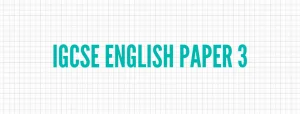
Paper 3 Assessment
| Duration | 2 hours |
|---|---|
| Number of Questions | 2 |
| Total Marks | 50 |
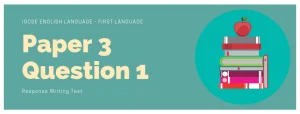
Question 1 - Response Writing Task [25 marks]
The IGCSE English paper 3 question 1 asks for realistic and coherent writing as it is based on a realistic situation. An example of what the question looks like.
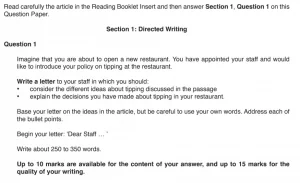
What does Question 1 expect you to do?
Write 250-300 words in response to a reading text.
What do you have to write?
You will have to write one of the following:
- A letter
- A newspaper report
- A magazine article
- A dialogue
- The words of a speech
- A diary/journal entry
Marking Scheme for IGCSE English Paper 3 Question 1
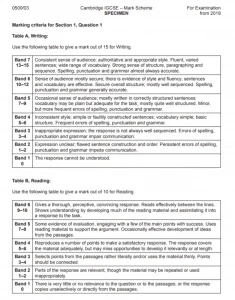
To view the official mark sheet, you may follow this link.
Tips for the IGCSE English Paper 3 Question 1
Tip 1 - Reading Thoroughly
As seen from the marking scheme, 10 marks are allocated to the Reading part. This means that reading accurately and understanding the content as well as the context of the text is important for you to score this section.
Learn to make inferences from what you have read from the text. When you make coherent inferences, it will allow you to gain a deeper comprehension of what the text is trying to convey. It also helps add to thoughtful, logical and coherent ideas to what has been written to develop and extend it.
This also applies to reading what is written in the bullet points carefully. One of the bullet points is usually testing on the understanding of the implicit meaning of the text, therefore making a thorough inference from the text would help you to write a good piece for this question.
Tip 2: Structure and plan your piece logically
Since the question states what should be included in your writing (in bullet points) it is best to follow and make sure you have the bullet points covered in your piece. You should write one paragraph addressing each bullet point. Always go back to the bullet points to make sure you are not out of context.
Planning your piece would help you to see and get an overview of how you will be writing. During this process, you can make sure your piece is able to flow logically.
Tip 3: Use TAP and PEEL
TAP stands for Topic or Task.
This is the topic that you will write about and it will help you determine what is the objective of your piece and what should be included in your writing.
A in TAP stands for Audience.
Ensure you are aware of the audience of your piece, in other words, who is going to be reading your piece in the question. It is important to be aware of your target audience before you start scripting your writing as it gives you a better perspective of what to write given what the audience is looking for.
P in TAP stands for Purpose
What is the reason you are writing this piece? Based on your question, you should be able to identify the objective and purpose of your writing. Make sure your purpose is clear in your writing, for example, you are writing a newspaper report, make sure you write it in a formal and unbiased tone reporting on relevant information and keeping in all the important key points.
For every paragraph, you can use the PEEL structure to help your paragraphs follow in a logical manner. Refer to this image to get an overview of what the PEEL structure is about.
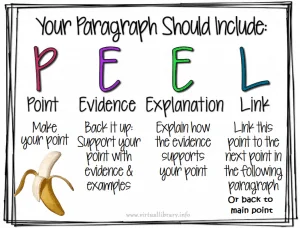
The PEEL structure will be able to help you write each paragraph with a specific point which allows your audience to immediately grasp the content of your paragraph.
The Point should be in the first sentence of the paragraph so it is clear. You should always link back to the point that you are addressing at the end of the paragraph so that you are not out of context and you having a closing for the paragraph.
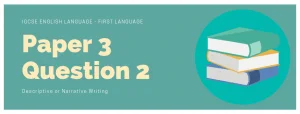
Question 2 - Choice of either narrative or descriptive writing (only choose one) [25 marks]
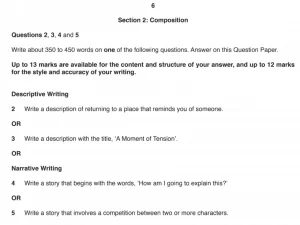
What do you have to write?
Either descriptive or narrative writing.
Take a look at the mark scheme here
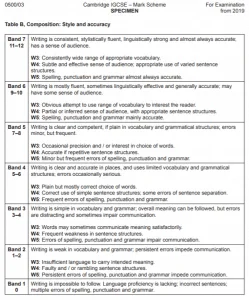
To view the official mark sheet, you may follow this link.
IGCSE English Paper 3 Question 2 Tips
Tip 1 - Select your task carefully
Descriptive and narrative compositions are different. They follow different conventions and are structured differently. Narrative compositions include a description in them, but these descriptions do not contain a plot. It is best to be aware of what the descriptive and narrative compositions are looking for.
The IGCSE English paper 3 can be hard to tackle if students are not aware of what is the objective of the questions. Learn how to read carefully and infer thoroughly is one tedious skill to master, however with the help of a professional, you will be able to master any reading piece and of course, the IGCSE English writing paper.
Tip 2: Craft your sentences
This tip applies to both narrative and description composition, whichever you composition you choose to write, make sure you use a variety of sentence types, from minor to complex. Varying your sentence like using colons and semi-colons for impact. If you used dialogue in your narrative, make sure to punctuation correctly. Crafting your sentences also means being accurate in your spelling and punctuation.
Narrative Writing
Unlike descriptive writing, you focus on the plot rather than descriptive details. It is usually written in the first or third-person perspective.
The best tip to give for a narrative writing piece would be choosing believable scenarios. It may help you to draw on your real-life experiences to achieve this. Choose a story you can complete in time.
Tip: Planning a clear structure
If you are writing a narrative, plan your story with a clear hook, conflict, climax and resolution.
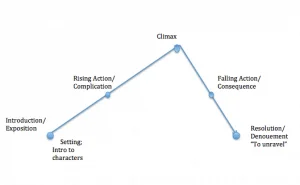
Having a powerful climax and resolution to your narrative gives your reader the greatest satisfaction. Learn to view your story as the reader would view it. This means taking your reader’s investment of time and emotions into account.
Planning before writing also allows you to have a clear overview of how you want your story to play out. You will be able to better express your thoughts and content into the story making sure your story follows smoothly from start to finish. This applies to writing a descriptive composition as well.
Descriptive Writing
Tip: Use Vivid Description
Articulate and express your descriptions with adjectives and be as clear and concise as you can with your writing. It is called descriptive writing for a reason!
Describe characters using detailed imagery, you can scatter physical description throughout multiple scenes to make your story and character come to life.
Describe actions to reveal physical characteristics. An example would be
“As we’d been talking, she’d pulled [her hair] into a high, loose bun with shorter pieces of hair falling around her face.” -Prep by Curtis Sittenfeld
Describe the way characters in your composition move or carry themselves. An example would be
“She was a slender, small-breasted girl, with an erect carriage, which she accentuated by throwing her body backward at the shoulders like a young cadet.” -The Great Gatsby by F. Scott Fitzgerald
You can visit this link to find the 10 tips for writing physical description of your characters.
About Tutopiya
For other more resourceful IGCSE curriculum study guides or curriculum guides, visit Tutopiya’s blog page here. Read on this Quick IGCSE Subject Guide to help you choose your IGCSE subjects!
Tutopiya offers a free 60 minutes complimentary trial to all new students. Our IGCSE English tutors are qualified and experienced with little details to the IGCSE English papers and they are aware of what examiners are looking out for in these the IGCSE English paper. It is always to have help near you. Feel free to live chat us to enquire more about the tutors and curriculums we provide here.
You can also sign up here or fill up a trial form here.
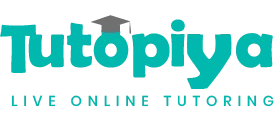
Written by
Tutopiya Team
Educational Expert
Related Articles

IGCSE Math Study Tips - Science-based Study Tools To Ace Your Exams
The IGCSE Math syllabus builds students' foundation for mathematical concepts. This prepares students for tertiary mathematics

Expert IGCSE Maths Tutor in Hong Kong | Personalized Lessons
Expert IGCSE Maths tutors in Hong Kong offer personalized lessons for top grades. Unlock your potential with tailored tuition for IGCSE, IB, & A-levels.

Tutopiya: Revolutionizing IGCSE Tutoring for Academic Success
What Makes Tutopiya the Best Choice for IGCSE Tutoring. The _IGCSE exams_ are a significant milestone in a student's academic journey


